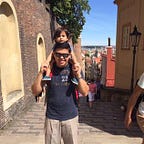Sarcophagus — A Dead Man’s Switch
A blockchain solution to protect you from the unforeseen
Since the dawn of time, people have worked to amass value and worth to help build generational wealth, make the best life for themselves, or even help serve a larger philanthropic purpose. The one thing that mankind can’t do is know when the unforeseen may happen: death, abduction, political uncertainty… In these cases, what happens to the belongings of those poor unfortunate souls? They become lost, tied up in some legal battle, or worse confiscated. Sarcophagus is a blockchain-based solution to help solve this problem. By implementing a decentralized dead man’s switch, the digital assets of an individual can be safely passed onto a chosen individual through the execution of a smart contract. Sarcophagus introduces a digital safeguard that protects your assets the way that you see fit.
Project Overview
The Sarcophagus project is a blockchain-based project built and developed on the Ethereum network in conjunction with Arweave. It accomplishes the protection of digital assets by the use of a decentralized dead man’s switch.
A dead man’s switch is a mechanism (digital or physical) that triggers when the user fails to perform an action.
The combination of Ethereum’s network and the permanent file storage network that Arweave provides is the perfect storm for creating the dead man’s switch that Sarcophagus offers. From a technical perspective, it works because Ethereum allows for an immutable contract to be hosted for the duration of the contract and Arweave’s technology allows for files to be stored and retrieve upon execution. The perfect storm of technology to protect assets from the unforeseen.
Making A Sarcophagus
As a way of making the project more understandable and less focused on technical speak, terms relating to Egyptian mummies were used to describe the process of building a Sarcophagus.
The process of developing a Sarcophagus, or the decentralized dead man’s switch can be broken down into 3 steps:
- Mummification — A mummy is made from the data to be stored, also called the corpse, for encryption with the recipient’s public keys. This is what will be handed over in the execution of the dead man’s switch.
- Re-Wrap — To start the contract and ensure that the embalmer, the person making the sarcophagus, is sure that they want to create the sarcophagus, they are required to ‘re-wrap’ the sarcophagus. The embalmer additionally chooses and confirms with an archaeologist, the entity running and hosting the node for the protocol, to go live with the finalization of the sarcophagus. The trust in the archaeologist is made to execute the contract through incentivization from the embalmer’s fees.
- Resurrect — From the time that the embalmer creates the contract, loaded with the corpse, with the archaeologist. The sarcophagus remains locked until certain conditions are met. The embalmer at any time can repeat the re-wrap step to add additional time or conditions to the sarcophagus, the archaeologist is able to open the sarcophagus if the contract time has expired to recover his rewards, but the corpse is still only available to the recipient whose public keys were used to encrypt it.
Explanation of key items/roles in Making a Sarcophagus:
Sarcophagi — The file that sits on the Arweave network is wrapped, re-wrapped, and ultimately opened by both the Archaeologist and Embalmer. Two layers of encryption enable the sarcophagus to be handled and ultimately reward the Archaeologist as well as pass on the digital goods to the target recipient of the ‘corpse’ or digital goods.
Embalmer — The creator of the Sarcophagus and the one who wants to protect their goods. To go through the process of securing their assets, the embalmer is required to choose the payload, define a resurrection time, pay the ‘digging’ or transaction fees, and sets the bounty reward and terms for the re-wrapping sarcophagus with the Archaeologist.
Archaeologist — The role of the archaeologist is to hold and maintain the sarcophagus and to only open it once the conditions are met in the agreement made with the embalmer. From a technical standpoint, an archaeologist is a person who runs the sarcophagus node and hosts the sarcophagus. The archaeologist is incentivized through bonding SARCO tokens of equal amount with the embalmer and receives those upon completion and unwrapping of the sarcophagus.
Resurrection — This term relates to the time that the archaeologist opens a Sarcophagus. The resurrection time is set by the embalmer and once that time has expired, the archaeologist will open the sarcophagus to receive his rewards and reveal the inner sarcophagus which can be encrypted with the public key of the desired recipient. Archaeologists are very keen to monitor the resurrection time as their rewards are based on them opening the sarcophagus at those times within a grace period.
The Curse — This represents the unilateral contract that the embalmer makes with an archaeologist. The embalmer makes the contract that will guarantee that the sarcophagus will be looked after and maintained by the archaeologist. The output of the curse only affects the archaeologist as they will either be rewarded or receive a slashing penalty for proper maintenance and opening of the Sarcophagus.
Slashing — To keep archaeologists honest, they can be penalized for opening the sarcophagus early, forgetting to resurrect a sarcophagus, or opening the sarcophagus late (after the grace period). Slashing penalties include burning transactional fees, the bounties paid to the archaeologist, and the bonded fees that the archaeologist posted. Future metrics will be maintained on archaeologists that have poor performance.
Sarcophagus Community
In these early days of the project, the Sarcophagus community is slowly building and generating a community to help bring awareness, energy, and interest into the project. The Sarcophagus community is looking for enthusiastic individuals who would like to help spread the word about the project through social media.
Additional resources and information about the project can be found in the links below:
